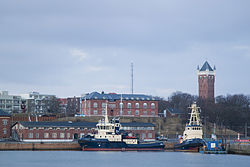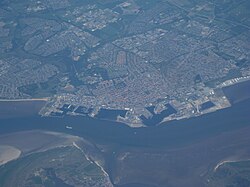Esbjerg, Denmark
| Esbjerg | ||
|---|---|---|
 |
||
|
||
 Aerial view of Esbjerg |
||
| Location in Denmark | ||
| Coordinates: 55°29′N 08°27′E / 55.483°N 8.450°ECoordinates: 55°29′N 08°27′E / 55.483°N 8.450°E | ||
| Country | Denmark | |
| Region | Southern Denmark (Syddanmark) | |
| Municipality | Esbjerg | |
| Established | 1868 | |
| City charter | 1899 | |
| Current municipality | 1 January 2007 | |
| Government | ||
| • Mayor | Johnny Søtrup | |
| Area | ||
| • City | 742.5 km2 (286.7 sq mi) | |
| • Urban | 15 km2 (6 sq mi) | |
| Elevation | 11 m (36 ft) | |
| Population (1 January 2016) | ||
| • Urban | 72,151 | |
| • Urban density | 97/km2 (250/sq mi) | |
| • Municipal | 115,748 | |
| Time zone | CET (UTC+1) | |
| • Summer (DST) | CEST (UTC+2) | |
| Postal code | 6700-6715 | |
| Area code(s) | (+45) 7 | |
| Website | www.esbjerg.dk | |
Esbjerg (/ˈɛsbjɜːr, -bjɜːrɡ/; Danish: [ˈɛsbjæɐ̯ˀ]; West Jutish dialect: [ˈɛsbʲæa̯]) is a seaport town and seat of Esbjerg Municipality on the west coast of the Jutland peninsula in southwest Denmark. By road, it is 71 kilometres (44 mi) west of Kolding and 164 kilometres (102 mi) southwest of Aarhus. With an urban population of 71,618 (as of 1 January 2016[update]), it is the fifth-largest city in Denmark, and the largest in west Jutland.
Before a decision was made to establish a harbour (now the second largest in Denmark) at Esbjerg in 1868, the area consisted of only a few farms. Esbjerg developed quickly with the population rising to 13,000 by 1901 and 70,000 by 1970. In addition to its fishing and shipping activities, it also became an important centre for agricultural exports. Over the years, many of the city's visitors have arrived by ferry from Harwich, Essex, England, but this service closed in September 2014 having run since 1875. The harbour facilities are being expanded to answer the needs of the wind-turbine industry and container shipping traffic. Esbjerg is served by Esbjerg Airport with flights to Aberdeen, Scotland and Stavanger, Norway.
...
Wikipedia


